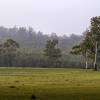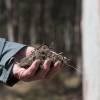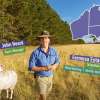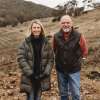
The Back Run demonstrate how integrating trees on farms can be done
Posted 22 June 2022
Managing trees On-farm benefits Economic benefits and markets Carbon benefits Tree Alliance
Private Forests Tasmania hosted a small field day for board members and invited stakeholders at the property of Tom and Sarah Clark, the Back Run in June.
The Back Run is one of PFT’s seven successful recipients of our round 1 Integrated Farm Forestry Demonstration Sites grant program to develop landscape scale best practice forestry plantings on their Ellendale and Westerway properties in the south of the state.
In 2019, the Clarks bought an adjoining property that had a large woodlot area of Eucalypt nitens on an 80ha block. The established nitens performed badly and were not suited to the area, its altitude or soil type. The Clarks strategically reviewed the property from a whole property plan level and identified areas where pasture belonged and areas which were better suited to commercial trees.
In 2021, the Clarks harvested the poor performing nitens and established a more durable 35-hectare Pinus radiata woodlot plantation. Another 14ha will be planted out across both their properties in July 2022 into both woodlot and shelterbelt configurations.
To date, the radiata is performing well. 37.600 open rooted seedlings sourced from Lanoma Forest Nursery were planted (1,045 stems per hectare) with a 92% survival rate, with browsing from wildlife being their biggest challenge thus far.
The Clarks are sheep, cattle and brassica seed crop producers. The woodlots and shelterbelts will provide significant benefits to their livestock production through shelter from prevailing winds and rain in winter and shade in summers intense heat.
To maximise the benefits of their trees, the Clarks have enlisted the services of Midway and Climate Friendly to potentially receive an early income from carbon farming as well as a longer-term income from their sustainable forest products at harvest time.
The Clarks have successfully lodged a project through the Australian Government Clean Energy Regulator, Emissions Reduction Fund plantation methodology.
Key messaging displayed by the Back Run includes but is not limited to:
- The importance of species selection;
- Whole farm planning;
- The multiple benefits of trees;
- Carbon credits; and
- Shelterbelts for agricultural productivity.

Share this Article
Latest Articles
-

04 November 2025
Prioritising outcomes for Tasmania's private forest growers in 2024-25
-

20 October 2025
Tasmanian High Soil Carbon Landscapes project
-

17 September 2025
Celebrating excellence at the Tasmanian Timber Awards
Archives
- ActivAcre hits milestone, calls for more farmers to get on board
- Napier's leading the way in sustainable forestry and carbon-neutral farming
- Sound science needed to assess carbon impacts of timber harvesting
- Newly appointed TFFPN Board of Directors
- Graduate Certificate of Forestry Scholarship
- Forestry Australia Mentoring Program 2025
- Forest Industry Roundtable planning for the long term
- Eagle Management Constraint Period extended
- Successful private native forest management celebrated
- $15 million investment in new ship loader to boost Bell Bay's forestry exports
- Standing with Tasmania's forestry industry: buy local
- TFPA: Tasmanian Freight Equalisation Scheme needs a ground-up review
- AFCA Gala Dinner celebrates industry excellence
- Fire permits now required Statewide
- Forest leaders hone skills in sustainable native regrowth management
- Tasmanian forests and the carbon market: Barriers and opportunities
- What the 2024-25 Tasmanian Budget means for forestry
- Spring is the time for fuel reduction burning
- Primed for Growth: A situation analysis of the Tasmanian Forest and Wood Products Sector
- Audit requirements cut for low-risk plantation projects
- Guidance and support for landowners after damaging winds
- Forestry Australia welcomes further definition of active forest management
- Farm & Forest Mapper Tool highlighted at Rural Youth Tasmania's Young Farmer of the Year competition
- Senate Select Committee inquiry into the Tasmanian Freight Equalisation Scheme
- Timberlink announces new wood composite products brand
- Newly developed protocol a vital tool for safeguarding forestry industry
- Red Hot Tips: Fire management for Tassie farmers
- Bioenergy: Fuelling industries with trees
- Harvesting trees: What you need to know
- Shelterbelts: How are they contributing to farm systems?
- Infill plantings and remnant vegetation: Why biodiversity depends on a thriving understory
- Plantation planning: The key to a successful plantation
- Exciting interactive forestry knowledge hub launched
- $450,000 farm forestry grant recipients revealed


